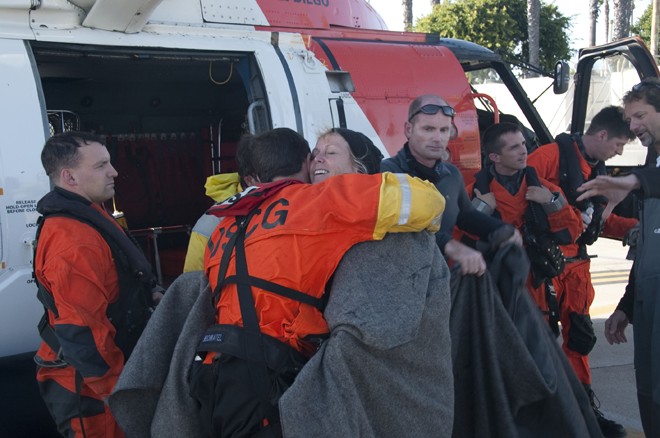Anatomy of a Rescue - and why EPIRB's are vital for sailing boats
by John Bell/Sail-World Cruising on 27 Nov 2009

Am I glad to be home - Crewmembers from the sailing vessel Crosswave disembark from a MH-60J Jayhawk helicopter at Coast Guard Sector San Diego, Wednesday, Oct. 28, 2009. - photo US Coast Guard SW
This description of an unavoidable incident at sea and its aftermath is a copybook account of how modern rescues should work - but the story could have been very different if there had not been an EPIRB on board.
They were a disciplined team of two sail instructors and three students from the J World Performance Sailing School participating on October 28th in the Baha Ha Ha rally from San Francisco to Cabo San Lucas, Mexico. One of the instructors aboard the 40 foot sailing boat was Barry Demak.
The crew was sure they were well prepared for emergencies, Demak said, because they had pre-packed an ACR Electronics' RapidDitch Bag with safety and survival gear and the boat had an ACR SATELLITE2 406 EPIRB mounted in a bracket inside the cabin.
Fifty miles off the Baja Peninsula, the five crew happened upon a pod of humpback whales and were jolted by an impact with one of the giant mammals. The steering rudder became completely dislodged and tremendous amounts of water began pouring into the disabled vessel.
For 45 minutes everyone attempted to keep the boat afloat. Crew members furiously pumped the manual bilge pump, while the others tried to secure the rudder and slow the ingress of water. Although they were stunned by their urgent situation, the crew went about their tasks.
Traditional means of communicating their plight proved unsuccessful. They had placed Mayday calls on the VHF radio in Spanish and English but there were no answers. They were out of cell phone range.
Eventually they realized they couldn't stem the flow of seawater. Captain Eugenie Russell grabbed the EPIRB and brought it on deck and assigned a crew member the important task of protecting the EPIRB, eventually transferring
it to the life raft. Some minutes later when it was clear that abandonment was imminent, Captain Russell activated the satellite-detectable emergency distress signal.
Captain Russell went below to retrieve the RapidDitch bag and water already was above her knees. According to Demak, ³at that point things began to accelerate. Demak also went down below to secure additional food and water
and found seawater at waist level. Russell, Demak and crewman Ray Quinn went forward to deploy the life raft. Finally, with the deck going underwater, the crew went into the water and held onto the raft. They scurried into the
covered life raft, bailed out cold seawater for over an hour, took stock of their emergency stores, read the raft survival instructions and then floated in windy, high seas awaiting rescue.
'We were absolutely confident that once we were in the life raft, we would be located and would be rescued. We were confident because we had the EPIRB and because of our relative proximity to San Diego,' he said.
Around 2 p.m., they heard a USCG Jayhawk helicopter in the distance. The elated survivors used their VHF radio to make contact, and Captain Russell launched a flare. A USCG C-130 aircraft from Sacramento provided long-range
coverage. The helicopter crew hoisted all five sailors safely aboard for transport to San Diego, where Russell later received medical care for a minor hand injury.
USCG Petty Officer 3rd Class Henry Dunphy described the rescue as 'pretty incredible' because of how isolated the racers were and how flawlessly the technology worked. 'The first sign of trouble came to us from the EPIRB signal. As soon as we got the signal, we launched right away. The EPIRB brought us right to them. Then survivors set off flares and we went straight to the raft. Everyone who owns a boat should have an EPIRB,' Dunphy said.
Demak reiterated the importance of the EPIRB in his rescue. 'Without question, having the EPIRB and knowing how to use it saved our lives. Everybody needs to understand how to register the EPIRB with accurate and up-to-date information. Our actions and our level headedness helped, as well as being prepared with the right equipment,' he said.
About EPIRBs:
An EPIRB is a satellite-signaling device of last resort, for use when all other means of self-rescue have been exhausted and where the situation is deemed to be grave and imminent, and the loss of life, limb, eyesight or valuable property will occur without assistance.
In most countries of the world beacons must be registered with the relevant authorities following purchase. This also aids in identification if the EPIRB is ever used.
The EPIRB used in this story was manufactured by www.acrelectronics.com!ACR_Electronics,_Inc., who manufacture many safety and survival products including PLBs, AIS, SARTs, Strobe Lights, Life Jacket Lights, Search Lights and safety accessories, registered to the ISO 9001:2008 Series Standards.
.............................
Message from Reader:
Sender: Christine Short
Message: I couldnt agree more- The first sign of trouble on Andrew Short boat was the personal EPIRB activated by a crew member- no mayday was able to be sent as the mast had come down- we had contact by Search and resucue verifying details within 5 min- awesome technology
Related News Item: Anatomy of a Rescue - and why EPIRB's are vital for sailing boats
...........................
If you want to link to this article then please use this URL: www.sail-world.com/63784